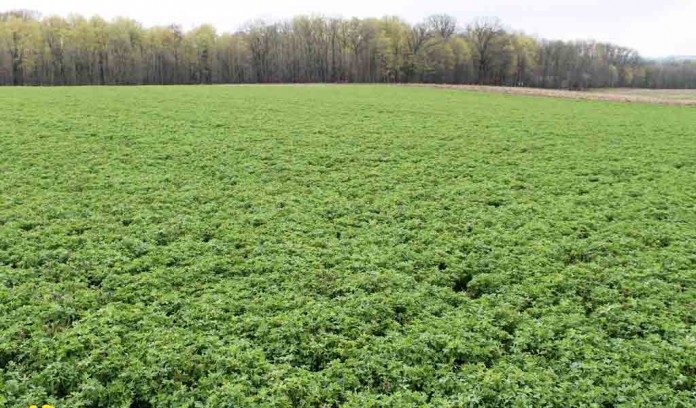As trends go this fall, questions about alfalfa rose to the top of the list. It seems the fall armyworm outbreak, which turned leafy fields into landscapes of leafless stem, left many of us scrambling to figure out what to do about it. It was almost an overnight occurrence.
We still find ourselves scouting to see if we will see a second-generation before cold weather sets in, but I am hopeful cooler nights will prevail. Not everyone had an issue, but it is easy to find farms with large acres impacted. Because of all the attention given to the fall armyworm problem, it’s been a good year to review our guidelines and recommendations for growing alfalfa.
Fertilizer guidance
A recent soil test sparked several questions about nutrient recommendations, what fertilizer sources to use and timing the fertilizer application. At Ohio State University, we have three great resources for dialing in on agronomic and fertilizer guidance: the newly updated “Tri-State Fertilizer Recommendations” and “The Ohio Agronomy Guide, and the Corn, Soybean, Wheat, and Forages Field Guide,” co-branded with Penn State Extension. I also look at the Penn State Agronomy Guide from time to time to see how they discuss recommendations, also.
Fertilization is generally best in the fall or after a first cutting. Phosphorous and potassium are essential to manage for vigorous plant growth and stand persistence. Split applications can be useful to spread the cost in high-demand situations and to feed more gradually, avoiding luxury consumption of potassium.
We often look for pH to be slightly higher than recommended for corn. A pH of 6.5 to 6.8 is recommended for alfalfa, where a pH of 6.0 to 6.5 is recommended in a cornfield.
At OSU Extension, we use a build and maintenance approach to make a fertilizer recommendation. Phosphorus and potassium recommendations for alfalfa follow that model. When phosphorus soil test levels are between 30-50 ppm Mehlich 3, we apply fertilizer based on nutrients removed during harvest. When soil test levels on a soil test report are below that range, we make a calculation to apply more phosphorus to raise soil test level phosphorus. The good news is there are simple tables that help make a phosphorous application determination a fairly simple process. These tables exist in the “Tri-State Fertilizer Recommendations” document. A balanced P&K program is needed to maintain yields and stand persistence.
Nitrogen
Nitrogen is extremely important for good production of grasses, but generally not needed on alfalfa. In fact, any field with greater than 35% legume content should be managed without a nitrogen application.
That being said, we may find ourselves in markets where something like an 18-46-0 fertilizer are most convenient and available to us, and put down a little nitrogen as we go.
This soil test for the field in question tested at 9 ppm. At that rate, OSU’s Tri-State Recommendations document suggests 150 pounds of phosphorus (P205) to meet a yield goal of 4 tons per acre. If the field had tested in the maintenance range, the recommended application of phosphorus (P205) is 50 pounds per acre. We remove about 12 pounds of available phosphorus per ton of harvested forage biomass and 49 pounds of potash.
Regrowth
We minimize fall harvest of tall legumes in order to mitigate heaving and winterkill. In central Ohio, Sept. 12 is the recommended last regular harvest date. Maybe you choose to push a little further and harvest closer to the end of September, but history tells us risk of winterkill is greater. I have had a few conversations where for one reason or another, the final cut gets pushed back. I will always give you the book answer so at least you know the risk.
While we can find fall armyworms in some capacity most years, many of us were surprised by how widespread and abundant the infestation was this fall. It was unusual to see the alfalfa fields stripped of their leaves in so great of an area. One outbreak is not necessarily detrimental, but it all comes down to timing and environmental conditions.
Alfalfa will regrow, but there will be concern about the ability of the stand to provide the reserve carbohydrates and the risk of the new generation feeding off the new growth.
I do think there is probably a little bit of art scattered into the science. Agronomic guidelines like these come from years for solid research, but we know there is field variability and years of experience lead to adjustments and fine-tuning. If you are starting out, find the extension resources mentioned here and they will help get you well on your way.













